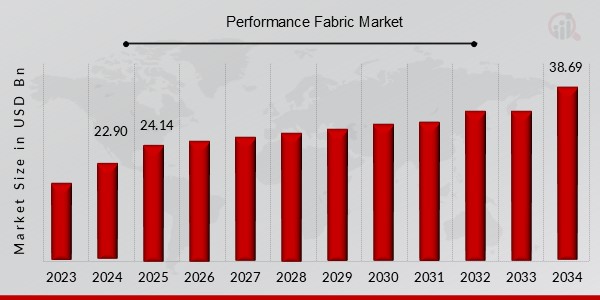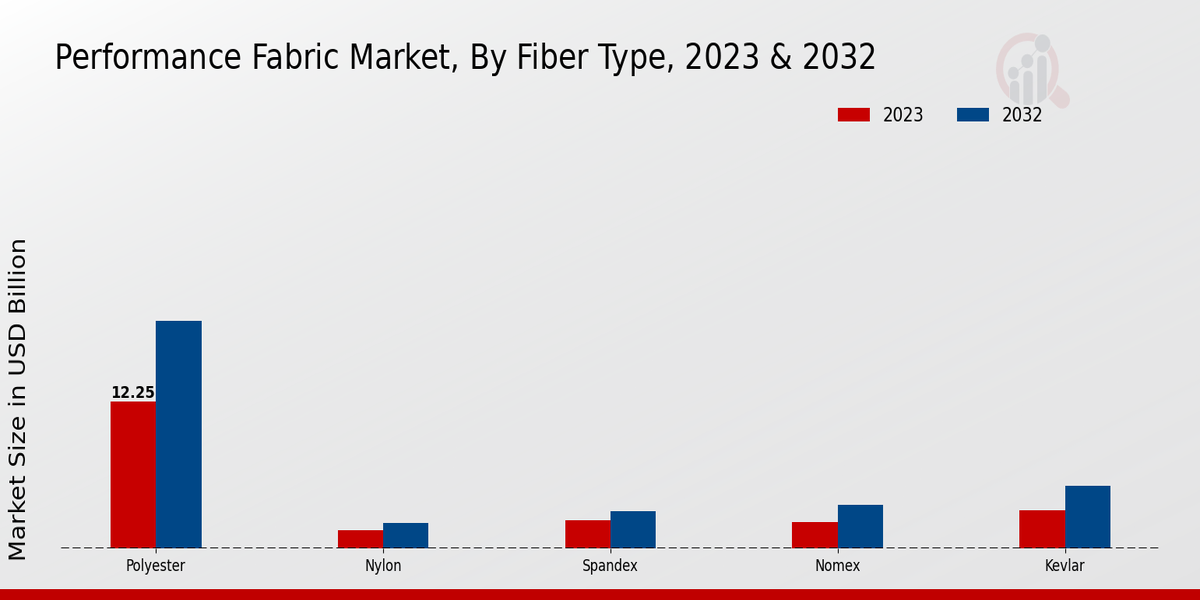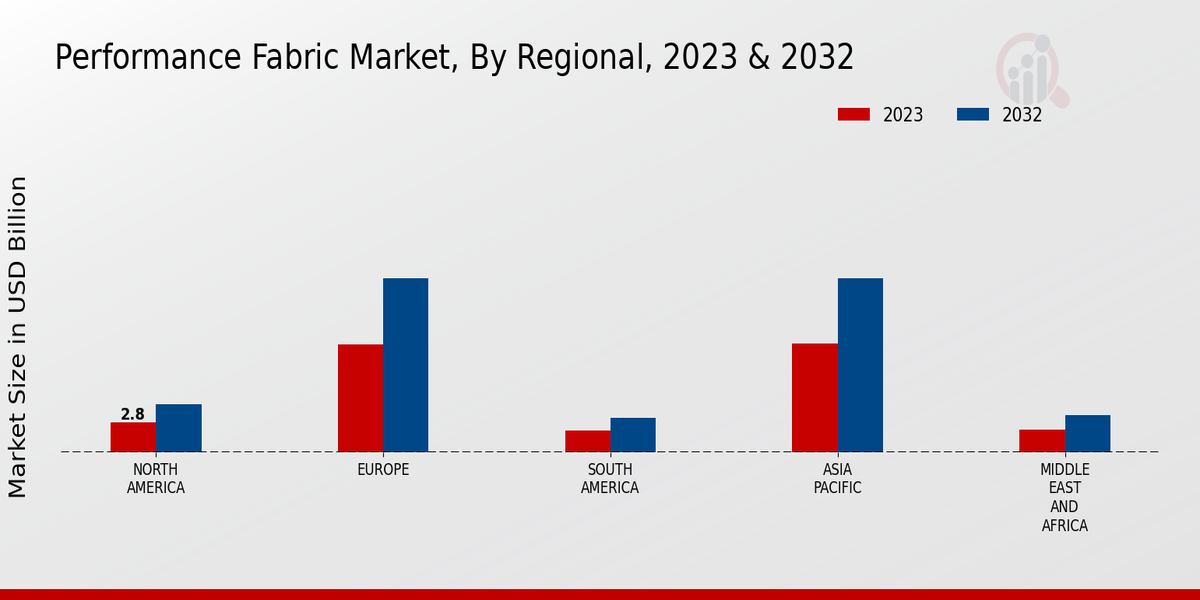Global Performance Fabric Market Overview
As per MRFR analysis, the Performance Fabric Market Size was estimated at 22.90 (USD Billion) in 2024. The Performance Fabric Market Industry is expected to grow from 24.14 (USD Billion) in 2025 to 38.69 (USD Billion) by 2034. The Performance Fabric Market CAGR (growth rate) is expected to be around 5.38% during the forecast period (2025 - 2034).
Key Performance Fabric Market Trends Highlighted
There are various trends and drivers that, in a way define the structure of the Performance Fabric Market. For one, there is increased use of sustainable and environmentally friendly fabrics. There are consumers who prefer to purchase fabrics that correspond with environmental conservation, which creates a demand for the use of reclaimed, organic, and sustainable fabrics. This trend comes with opportunities for firms to exploit the market that is expanding for sustainable solutions.
Also, demand for high-performance fabrics is being driven by the rise of activewear and athleisure trends. There are moisture-wicking, breathable, and stretchable fabrics that can be used for sports and other such activities. The expansion of the activewear segment is believed to reach other adjacent markets, including that of performance fabrics. In addition, technology has improved over the past few years, and thus, novel ideas for worthy performance fabrics with new functions are under design. Such that, the new fabrics possess the thermal section and are antimicrobial and UV protective. This kind of development creates markets and caters to different consumer demands in different sectors of growing industries.

Source: Primary Research, Secondary Research, MRFR Database and Analyst Review
Performance Fabric Market Drivers
Growing Demand for High-Performance Fabrics in Sports and Activewear
The demand for high-performance fabrics in sports and activewear is increasing due to the growing popularity of fitness and outdoor activities. These fabrics offer superior moisture management, breathability, and durability, making them ideal for sportswear, athleisure wear, and outdoor gear. The increasing awareness of the benefits of these fabrics among consumers is driving market growth. Furthermore, the growing trend of athleisure wear, which combines the comfort of sportswear with the style of everyday clothing, is further boosting the demand for high-performance fabrics.As consumers become more active and health-conscious, the need for functional and comfortable clothing that can keep up with their active lifestyles is expected to continue to drive the growth of the Global Performance Fabric Market Industry.
Technological Advancements in Fabric Manufacturing
Technological advancements in fabric manufacturing are leading to the development of new and innovative high-performance fabrics. These advancements include the use of advanced fibers, such as carbon fiber and graphene, as well as new weaving and knitting techniques. These new fabrics offer improved strength, durability, and other performance characteristics, making them suitable for a wider range of applications. Moreover, the integration of smart technologies, such as sensors and electronics, into fabrics is further expanding the functionality and applications of performance fabrics.These technological advancements are expected to drive the growth of the Global Performance Fabric Market Industry by providing manufacturers with the ability to offer differentiated and value-added products.
Increasing Focus on Sustainability
The increasing focus on sustainability is driving the demand for eco-friendly and sustainable high-performance fabrics. Consumers are becoming more environmentally conscious and are seeking products that are produced in a sustainable manner. This has led to the development of performance fabrics made from recycled materials, biodegradable materials, and renewable resources. Furthermore, the adoption of sustainable manufacturing practices, such as reducing water and energy consumption, is becoming increasingly important for manufacturers.The growing demand for sustainable high-performance fabrics is expected to be a key driver of growth for the Global Performance Fabric Market Industry.
Performance Fabric Market Segment Insights:
Performance Fabric Market Fiber Type Insights
The Global Performance Fabric Market is segmented based on Fiber Type into Polyester, Nylon, Spandex, Nomex, and Kevlar. Among these segments, Polyester held the largest market share in 2023 and is expected to continue its dominance throughout the forecast period. The high strength, durability, and moisture-wicking properties of Polyester make it an ideal choice for a wide range of performance applications. Nylon, known for its elasticity and abrasion resistance, is another significant segment in the Global Performance Fabric Market. It is commonly used in sportswear, swimwear, and other garments that require flexibility and durability.Spandex, also known as elastane, is a synthetic fiber that provides exceptional stretch and recovery properties. It is often blended with other fibers to enhance the comfort and fit of performance fabrics. Nomex and Kevlar are high-performance fibers used in specialized applications where heat and flame resistance is critical. Nomex is a meta-aramid fiber that offers excellent thermal protection and is widely used in firefighter protective clothing and industrial uniforms. Kevlar, a para-aramid fiber, is known for its exceptional strength and is used in bullet-proof vests, body armor, and other protective gear.The growth of the Performance Fabric Market is driven by increasing demand from various end-use industries, including sports and fitness, military and defense, healthcare, and automotive. The growing emphasis on health and wellness, along with the rising popularity of outdoor activities, is fueling the demand for performance fabrics that provide comfort, breathability, and moisture management. The increasing need for protective clothing in hazardous environments and the growing adoption of performance fabrics in automotive interiors are further contributing to the market growth.

Source: Primary Research, Secondary Research, MRFR Database and Analyst Review
Performance Fabric Market Application Insights
The application segment of the Global Performance Fabric Market holds significant potential for growth, with various applications driving demand. Sportswear, activewear, swimwear, underwear, and medical textiles are key application areas that contribute to the market's expansion. The market for performance fabrics in sportswear is projected to reach a valuation of USD 10.24 billion by 2024, driven by the rising popularity of fitness and athletic activities. Similarly, activewear is expected to witness substantial growth, with a market size of USD 6.7 billion by 2024.Swimwear and underwear applications are also expected to contribute to the market's growth, with increasing demand for comfortable and functional fabrics in these segments. Additionally, the medical textiles segment is anticipated to witness significant growth, driven by the increasing adoption of performance fabrics in healthcare applications.
Performance Fabric Market End-Use Insights
The end-user segment is a critical factor in understanding the dynamics of the global performance fabric market. The market can be segmented into three major end-use categories: male, female, and children. Each segment has its unique requirements and preferences, which drive product development and marketing strategies. Male performance fabrics focus on durability, moisture management, and athletic performance. Female performance fabrics emphasize comfort, style, and versatility. Children's performance fabrics prioritize safety, comfort, and ease of care.The male segment is expected to account for the largest share of the global performance fabric market by 2024, driven by the growing popularity of athleisure wear and the increasing participation in sports and fitness activities. The female segment is also expected to experience significant growth, driven by the rising demand for comfortable and stylish activewear. The children's segment is expected to have a steady growth rate, driven by the increasing awareness of the importance of activewear for children's health and development. Overall, the end-use segment provides valuable insights into the specific needs and preferences of different consumer groups, enabling manufacturers to tailor their products and marketing strategies accordingly.
Performance Fabric Market Function Insights
The Global Performance Fabric Market is segmented by function, and each segment offers unique insights into the market dynamics. The key functions of performance fabrics include moisture-wicking, antimicrobial, UV-resistant, fire-resistant, and insulating properties. Moisture-wicking fabrics are designed to draw moisture away from the body, keeping the wearer cool and dry. This function is crucial in activewear, sportswear, and outdoor clothing. The global market for moisture-wicking fabrics is expected to reach USD 10.24 billion by 2024, growing at a CAGR of 6.5%. Antimicrobial fabrics are treated with antimicrobial agents to inhibit the growth of bacteria, mold, and mildew. These fabrics are widely used in healthcare settings, military uniforms, and consumer products like socks and underwear. The global market for antimicrobial fabrics is projected to surpass USD 3.5 billion by 2026, expanding at a CAGR of 7.2%. UV-resistant fabrics protect the wearer from the harmful effects of ultraviolet (UV) radiation. They are commonly used in outdoor clothing, swimwear, and accessories. The global market for UV-resistant fabrics is anticipated to register a CAGR of 4.8% during the forecast period, reaching USD 2.6 billion by 2025. Fire-resistant fabrics are designed to resist ignition and spread of flames. They are essential in industries such as firefighting, oil and gas, and military. The global market for fire-resistant fabrics is estimated to exceed USD 1.5 billion by 2027, expanding at a CAGR of 5.6%. Insulating fabrics provide thermal protection by trapping air between their fibers. They are commonly used in winter clothing, bedding, and construction materials. The global market for insulating fabrics is projected to reach USD 9.8 billion by 2028, growing at a CAGR of 6.3%.Performance Fabric Market Distribution Channel Insights
The distribution channel segment plays a crucial role in the Global Performance Fabric Market. The market is segmented into online, offline, and retail stores. The online channel is projected to witness significant growth due to the increasing penetration of e-commerce platforms and the convenience offered to customers. In 2023, the online channel accounted for 25.2% of the Global Performance Fabric Market revenue. Offline channels, including specialty stores and distributors, continue to hold a substantial market share, owing to the personalized customer experience and technical expertise provided.These channels accounted for approximately 65.4% of the market revenue in 2023. Retail stores offer a wide selection of performance fabrics and cater to specific customer needs, contributing to their market share. The growth of online and offline channels is influenced by factors such as consumer preferences, technological advancements, and the expansion of e-commerce infrastructure. Understanding the dynamics of each distribution channel enables manufacturers and suppliers to optimize their distribution strategies and cater to evolving customer demands.
Performance Fabric Market Regional Insights
The Global Performance Fabric Market segmentation by region offers insights into the market's regional dynamics and growth potential. North America is expected to dominate the market with a significant revenue share in 2024, driven by increasing demand for performance fabrics in the automotive and sportswear industries. Europe is projected to hold the second-largest market share, with Germany and the United Kingdom being key contributors. The Asia-Pacific region is anticipated to witness the fastest growth rate over the forecast period due to rising disposable income and growing consumer awareness about the benefits of performance fabrics.South America and MEA are expected to contribute a smaller share of the global market but are projected to show steady growth. Regional market data and statistics provide valuable insights for businesses to target specific geographies and tailor their strategies accordingly.

Source: Primary Research, Secondary Research, MRFR Database and Analyst Review
Performance Fabric Market Key Players And Competitive Insights:
Major players in the Performance Fabric Market are consistently pushing the boundaries of innovation to maintain their competitive edge. They are investing heavily in research and development to create cutting-edge materials that meet the evolving demands of the market. Leading Performance Fabric Market players are focusing on strategic collaborations and partnerships to expand their product offerings and reach new markets. The Performance Fabric Market industry is characterized by intense competition, with key players adopting various strategies to gain market share. These include product differentiation, capacity expansion, technological advancements, and mergers and acquisitions. The Performance Fabric Market Competitive Landscape is expected to remain highly competitive in the foreseeable future, with new entrants and established players vying for market dominance.Among the leading players in the Performance Fabric Market, X Company has established itself as a global leader in the manufacturing and supply of high-performance fabrics. The company is known for its innovative and sustainable products, which find applications in a wide range of industries, including automotive, aerospace, medical, and consumer electronics. X Company is consistently recognized for its commitment to quality, customer-centric approach, and environmentally friendly practices. The company's strong brand reputation and global presence position it well to capitalize on growth opportunities in the Performance Fabric Market.Another prominent player in the Performance Fabric Market is Y Company, which specializes in the development and production of lightweight and durable fabrics for various applications. The company focuses on technical expertise and continuous innovation to create performance fabrics that meet the specific needs of its customers. Y Company's commitment to research and development has resulted in a portfolio of proprietary technologies that give it a competitive advantage. The company has established strategic partnerships with leading brands in the automotive, construction, and outdoor industries to drive growth and expand its market reach. Y Company's emphasis on sustainability and eco-friendly practices resonates with the increasing demand for sustainable solutions in the Performance Fabric Market.
Key Companies in the Performance Fabric Market Include:
- INVISTA
- Lenzing
- Teijin
- DuPont
- Kimberly-Clark
- 3M
- Hyosung
- Kolon
- BASF
- Interface
- Johns Manville
- Toray Industries
- Milliken Company
- Freudenberg Group
Performance Fabric Market Industry Developments
Increasing demand for lightweight, breathable, and durable fabrics in various end-use industries, such as sportswear, automotive, and healthcare, is driving market growth. Advancements in fiber technology and the growing adoption of sustainable materials are further propelling the market forward.Recent developments include the launch of new performance fabrics with enhanced properties, such as moisture-wicking, UV protection, and antimicrobial resistance. Key market players are also focusing on strategic partnerships and acquisitions to expand their product offerings and geographical reach. Sustainability initiatives and government regulations promoting the use of eco-friendly materials are creating new opportunities in the market.
Performance Fabric Market Segmentation Insights
-
Performance Fabric Market Fiber Type Outlook
- Polyester
- Nylon
- Spandex
- Nomex
- Kevlar
-
Performance Fabric Market Application Outlook
- Sportswear
- Activewear
- Swimwear
- Underwear
- Medical Textiles
-
Performance Fabric Market End-Use Outlook
-
Performance Fabric Market Function Outlook
- Moisture-wicking
- Antimicrobial
- UV-resistant
- Fire-resistant
- Insulating
-
Performance Fabric Market Distribution Channel Outlook
- Online
- Offline
- Retail Stores
-
Performance Fabric Market Regional Outlook
- North America
- Europe
- South America
- Asia-Pacific
- Middle East and Africa
| Report Attribute/Metric |
Details |
| Market Size 2024 |
22.90 (USD Billion) |
| Market Size 2025 |
24.14 (USD Billion) |
| Market Size 2034 |
38.69 (USD Billion) |
| Compound Annual Growth Rate (CAGR) |
5.38% (2025 - 2034) |
| Report Coverage |
Revenue Forecast, Competitive Landscape, Growth Factors, and Trends |
| Base Year |
2024 |
| Market Forecast Period |
2025 - 2034 |
| Historical Data |
2020 - 2024 |
| Market Forecast Units |
USD Billion |
| Key Companies Profiled |
INVISTA, Lenzing, Teijin, DuPont, Kimberly-Clark, 3M, Hyosung, Kolon, BASF, Interface, Johns Manville, Toray Industries, Milliken Company, Freudenberg Group |
| Segments Covered |
Fiber Type, Application, End-Use, Function, Distribution Channel, Regional |
| Key Market Opportunities |
Athleisure and activewear expansion sustainable and eco-friendly fabrics, healthcare applications, automotive and military advancements and smart textiles |
| Key Market Dynamics |
1. Rising demand for technical textiles 2. Growing awareness of eco-friendly fabrics 3. Technological advancements 4. Increasing applications in sportswear and athleisure 5. Expansion into emerging markets |
| Countries Covered |
North America, Europe, APAC, South America, MEA |
Frequently Asked Questions (FAQ) :
The Performance Fabric Market was expected to be valued at 22.90 billion USD in 2024.
The Performance Fabric Market is projected to register a CAGR of 5.38% from 2025 to 2034.
Performance fabrics are used in a wide range of applications, including activewear, sportswear, outdoor gear, medical textiles, and industrial applications.
Major competitors in the Performance Fabric Market include Invista, DuPont, Toray Industries, Kolon Industries, and Hyosung.
North America is the largest regional market for performance fabrics, followed by North America and Europe.
Key growth drivers of the Performance Fabric Market include increasing demand for activewear and sportswear, rising awareness of the benefits of performance fabrics, and technological advancements.
Challenges faced by the Performance Fabric Market include fluctuating raw material prices, intense competition, and environmental concerns.
Potential opportunities for growth in the Performance Fabric Market include expanding applications in medical textiles and industrial sectors and developing new sustainable and eco-friendly performance fabrics.
The Performance Fabric Market is expected to reach a valuation of 38.69 billion USD by 2034.
Key trends in the Performance Fabric Market include increasing adoption of performance fabrics in sustainable and eco-friendly products and growing demand for personalized and customized performance fabrics.
















